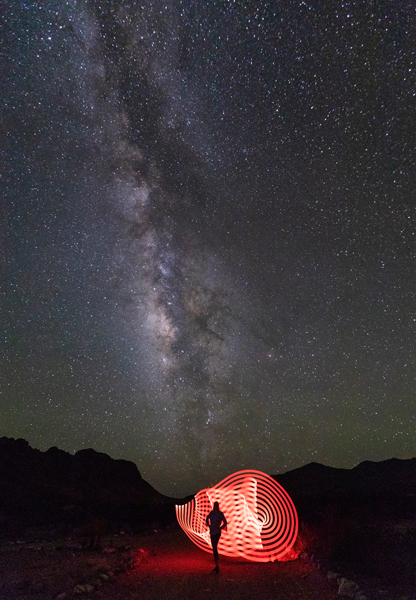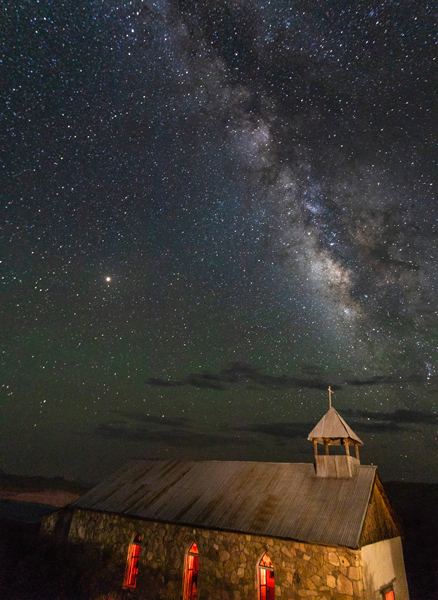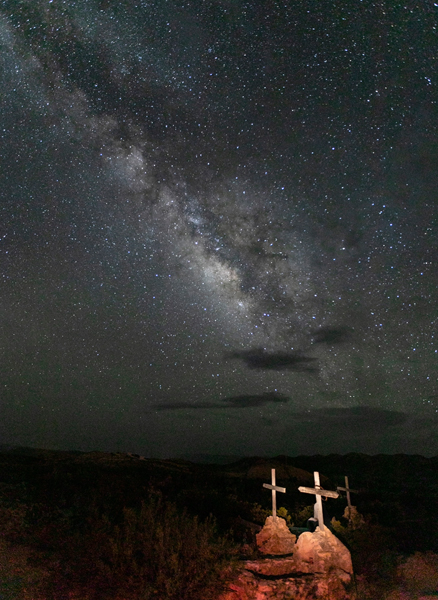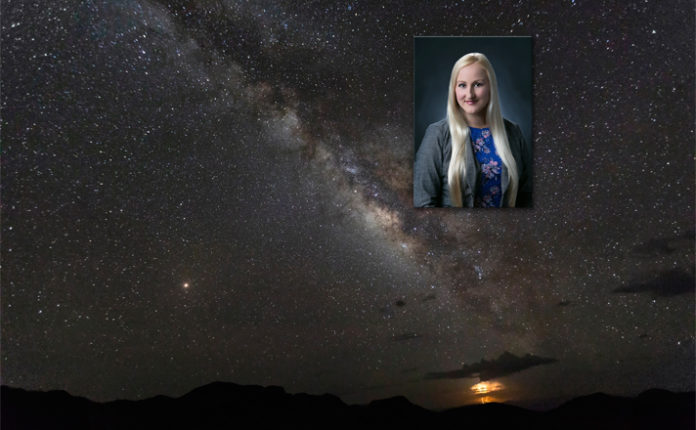by Alison Carlino
This year, my business celebrates fifteen years of documenting the lives of humans. In an effort to keep the inspiration flowing and pursue something different, I decided to turn my focus to the night skies, specifically the Milky Way and the galactic core. I have long admired the creative work by astro photographers who travel to amazing locations to capture landscapes by day and stars by night that take your breath away. But I soon discovered what a difficult journey these photographers endure.
While planning this adventure, I learned that there is actually a “Milky Way season” and that, in the northern hemisphere, the best viewing of the Milky Way is from late April to late July because the galactic core is visible for longer periods in the night sky. Although the Milky Way can also be seen during winter months, their core is not visible. In addition, I found a helpful blog called “National Parks at Night” which offers workshops around the USA on how to capture night skies, how to light paint objects, and how to handle post-processing. Essential to the process is a good understanding of the moon phases. Three days before a new moon, the night of the new moon, and three days after the new moon produce the least amount of light in the sky. This means the stars and the core are more visible.
The next factor to consider is location. A great source for this is “Dark Sky Finder” (www.jshine.net/astronomy/dark_sky/) which rates locations around the world by zones on a scale from 1 to 10, with 1 being the darkest sky. After seeing Houston lit up like a Christmas tree, my group of four adventurous photographers decided to “go west.” In fact, the darkest spot in the lower 48 states was only a 9.5 hour drive from Houston… Big Bend National Park. After noting the moon phases for a three month period, we decided on July 12-16.
We also learned of an app called PhotoPills (www.photopills.com) for $9.99 that uses augmented reality (AR) to overlay the position of the Milky Way to get an idea of our final compositions. This app even gives the correct time that the Milky Way will rise, when the core is vertical in the sky, and when it will fade away. It also provides times for the rise and set of the moon and the sun.
In the early morning hours of July 12, we began our journey. Nearly 10 hours later, we had a park pass and were picking the brains of park rangers at the Panther Junction Visitors Center for the best overlooks for viewing the stars, road conditions, driving times from one location to another, and what wildlife we could expect to see. With summer temperatures reading 109, we were glad we brought plenty of water. Texans are tough! Anything for a photo, right?
 We had acquired a camper trailer in a remote location and, on that first night, were literally able to step off the porch and capture the Milky Way. Just as the PhotoPills app predicted, the core became visible at 10:29 pm. By this time, adrenaline had taken over and we were anxiously anticipating what was to come. I remember tearing up and just pausing to reflect on God’s Hand of Creation. We continued to capture images until nearly 3:00 am. It was breathtaking.
We had acquired a camper trailer in a remote location and, on that first night, were literally able to step off the porch and capture the Milky Way. Just as the PhotoPills app predicted, the core became visible at 10:29 pm. By this time, adrenaline had taken over and we were anxiously anticipating what was to come. I remember tearing up and just pausing to reflect on God’s Hand of Creation. We continued to capture images until nearly 3:00 am. It was breathtaking.
Each of us brought similar photographic gear… heavy-duty tripods (a smooth ball head will make life easier), cameras with either intervalometers or shutter release devices, a variety of focal-length lenses (the wider your lens, the longer you can expose without trails showing), batteries and chargers, memory cards, headlamps with red lights, a flashlight for light painting, some speed lights with Eneloop batteries and transceiver, MagMod grid, gel pack and sphere, Pixelstick for light painting, iPhones with appropriate apps, notebooks with exposure notes, and a printed map of Big Bend and the Terlingua area. In addition, we brought along an enormous dose of courage because everything is much more difficult in the dark!
After several weeks of studying, reading, and watching videos, I had come up with a “starting point” for exposures of the core and the Milky Way: ISO 3200-5000 at 2.8 for approximately 20 to 25 seconds, White Balance at 3500 to 5000 Kelvin, Manual Focus, Mirror to “Lock Up,” turn on Long Exposure Noise Reduction, file size to RAW, and LCD brightness to 1, with two options for Focus… use auto-focus at infinity earlier in the day with gaffer tape on the lens ring, changing to manual-focus after… or, at night, using auto-focus to focus on the brightest star and then switching to manual afterwards. In addition, we would use the compass on the iPhone to locate southeastern and southwestern skies.
A s the night progressed, we remembered reading “What truly makes a Milky Way image sing is the foreground,” so we attempted to light paint the path from our camper towards the mountain range as the bottom compositional element. I even brought out the Pixelstick, had someone spin behind me, and captured my very first Milky Way Selfie! (below)
s the night progressed, we remembered reading “What truly makes a Milky Way image sing is the foreground,” so we attempted to light paint the path from our camper towards the mountain range as the bottom compositional element. I even brought out the Pixelstick, had someone spin behind me, and captured my very first Milky Way Selfie! (below)
The hardest lesson that night revolved around focusing and zooming in constantly to make sure I had the stars in focus. If I didn’t, obvious trailing would appear. This is a great feature when you set out to do it on purpose but definitely is not welcomed when you want a sharp core. The method of auto focusing on the brightest star and then setting it back to manual focus seemed to work best. Perhaps I was past the point of tiredness or perhaps I didn’t want to admit to needing my glasses, but it seemed I was setting the focus a lot!
On day two, we traveled back into the tiny town of Terlingua to scout locations at the Ghost Town. We framed compositions with our cell phones and noted directions with our iPhone compass before heading back into the park to enjoy the daylight sights of this national treasure. As dusk approached, we headed out to the Ghost Town to set up. After allowing some other photographers to finish their shots, we did some light painting on the crosses and the scene came to life (below and right).
 I discovered quickly that my flashlight was too powerful on spot beam so
I discovered quickly that my flashlight was too powerful on spot beam so
I placed it under my red shirt. This not only diffused the light but produced the red gel glow that looked nice with the bluer skies. Think of light painting as a studio lighting set up. If you paint from camera position, that would create a flat light. Consider side lighting at a 45 degree angle to create highlights and shadows or even back lighting for a more dramatic effect. If the object you want to paint is close to you, use short, quick swipes. If it’s farther away, use longer, slower side to side motions.
Day three found our group heading into the Chisos Mountain Basin area where temperatures were forecasted to be cooler. That evening, our chosen location to capture the Milky Way was the Sotol Vista Overlook, recommended by the ranger. This location (on title page) was quite high in elevation and I personally had to dig deep for courage once it got dark and a lightning storm rolled in. Laugh all you want, but lightning seems even scarier when everything else around you is so dark! Ahead of that incoming storm, we struggled with passing clouds blocking our view of the core but as they passed on and the lightning remained in the distance, we captured truly amazing images.
Some of the best advice I can give to those who wish to undertake such an adventure is to practice first! Then, plan your locations ahead of time and scout once you arrive to confirm. The weather isn’t in your control and can really have a negative impact on your Milky Way images if the skies aren’t clear. Finally, remember that everything is harder in the dark.
I have so much more to learn about the art of astrophotography. The next captures I want to attempt are water reflections of the Milky Way and star trail images with foreground components. May my next fifteen years in this industry be filled with nocturnal moments!
 Alison Carlino will be teaching a class at the 2021 Texas School of Professional Photography.
Alison Carlino will be teaching a class at the 2021 Texas School of Professional Photography.
Alison Carlino has 17 years in the industry and has seen the trends come/go. In this class, you will learn lighting off camera, modern posing, and the collections/products that have made her senior portrait & sports business wildly successful. Expect very little lecture and a lot of hands on.











